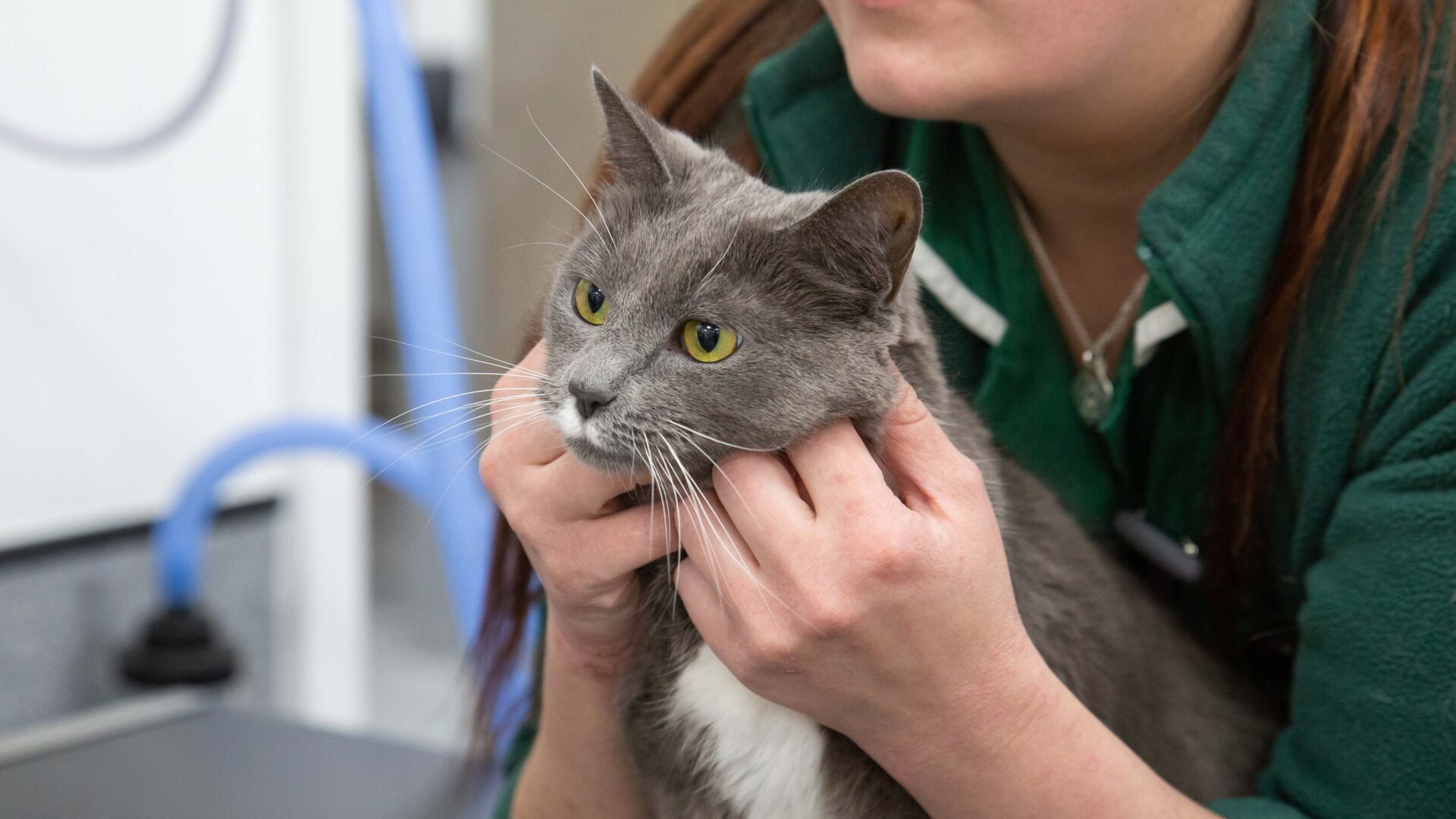Updated: 15/04/25
Neutering is a simple procedure that stops cats being able to have kittens, and is called castration in males and a spay in females.
Cats can be neutered at most ages, but many are neutered between four and six months of age to prevent unwanted pregnancies. Female cats don’t need to have had a litter to be neutered.
Neutering has numerous health benefits and can alleviate the strain on rescue centres. The recovery time is usually quick, and cats normally can go home the same day as the procedure.
If you have any further questions about neutering your cat or would like to book them in for this procedure, please contact your local veterinary practice for further support.
On this page:
- What is neutering?
- At what age can I book my cat in to be neutered?
- How does neutering prevent my cat from having kittens?
- Why should I get my cat neutered?
- What happens when my cat is neutered?
- How long will it take my cat to recover from being neutered?
- Commonly asked questions
- Useful resources
What is neutering?
The term ‘neutering’ refers to an operation that is done to prevent a cat from being able to reproduce.
This is often referred to as a ‘castration’ in male cats and a ‘spay’ in female cats.
What is the best age to get your cat neutered?
Cats reach puberty at around four months of age, so to prevent them accidentally having kittens, the safest option is to book them in to be neutered from four to six months old.
Cats can be safely neutered at most ages, and some vets will routinely neuter kittens much younger than this.
Adult cats can also be safely neutered at any age. Veterinary practices may have different policies regarding the age at which they neuter cats, so contact your practice for more advice if you are unsure.
You should always speak to your vet regarding the most appropriate time to neuter your individual cat, as factors such as their general health and breed may affect the advice given.
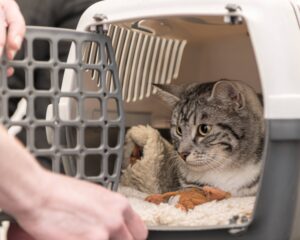
How does neutering prevent my cat from having kittens?
Neutering a cat is a surgical procedure to take away their ability to have kittens. In male cats, both testicles are removed.
This removes their testosterone (and drive to pursue unneutered female cats!) but it also means they no longer have the sperm to father kittens.
When female cats are neutered, either their ovaries (ovariectomy) or the ovaries and womb are removed (ovariohysterectomy).
Whether an ovariectomy or ovariohysterectomy are done will often depend on the vet performing the operation and your cat’s individual circumstances.
These procedures take away your cat’s ability to conceive and carry kittens.
Why should I get my cat neutered?
There are many benefits to having your cat neutered.
Cats are prolific breeders, and there are already thousands of cats in rescue centres looking for homes.
With this in mind, it makes sense to prevent unwanted litters and help to alleviate the strain these rescue centres already face.
What happens if I don’t neuter my male cat?
Male cats who aren’t neutered are at increased risk of:
- Fighting and getting injured.
- Catching FIV (feline immunodeficiency virus) and FeLV (feline leukaemia virus).
- Roaming large distances and being hit by cars or going missing.
- Spraying smelly wee to mark their territory and attract female cats.
- Stress related behaviours if they are unable to find a mate or involved in conflict with other cats.
What happens if I don’t neuter my female cat?
Female cats who aren’t neutered are at increased risk of:
- Having repeated litters of kittens.
- Catching FIV (feline immunodeficiency virus) and FeLV (feline leukaemia virus).
- Behavioural issues associated with repeated seasons.
- Mammary (breast), ovary and womb cancers.
- Womb infections (pyometra).
- Pregnancy complications and associated surgery.
Veterinary Nurse Hollie (RVN ISFMCertFN) says:
Cats are able to breed and produce kittens from four months of age! It is important to neuter your cat at an appropriate age to prevent unwanted pregnancies and reduce roaming and fighting.
What happens when a cat is neutered?
If your cat is booked in to be neutered, they will visit the veterinary practice as a day patient.
They will often be admitted in the morning and as for a human operation, you will usually have been asked to not feed them overnight and to withhold their breakfast.
When you drop your cat off, a member of the veterinary team will talk you through what will happen and ask you to sign a consent form.
You will also have the chance to ask any questions.
No anaesthetic is completely risk free, but modern veterinary medicine means that routine procedures such as neutering are generally very safe.
Your cat will then be taken through onto the ward, be weighed and have a check over prior to their operation.
Both male and female cats are neutered under a general anaesthetic. This means your cat is deeply asleep for the procedure and unable to feel any pain.
General anaesthetics can be achieved using different combinations of drugs and your vet will decide on the best combination to use based on your cat’s individual health situation.
Depending on which anaesthetic medications are used or whether your cat is also having a blood test taken, they may have a clipped patch on their front legs or under their neck.
When male cats are neutered, a small amount of hair is removed from the scrotum, the area is cleaned, and a tiny cut is made on each side to remove each testicle in turn. There aren’t any stitches and these cuts close very quickly.
When female cats are neutered, they will either have a clipped patch on their left side (for a flank spay) or on the underside of their tummy (for a midline spay). This area is then cleaned for surgery.
A small cut is made through the skin and muscle to open the abdomen and either the ovaries (ovariectomy) or the ovaries and womb (ovariohysterectomy) are removed.
Which option will be decided by the preference of your vet and may also be affected by factors such as if your cat is pregnant or has a womb infection.
The muscle and skin are then closed with stitches.
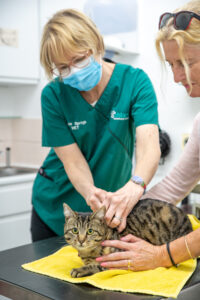
Pain relief is given so that it will already be working when the anaesthetic has worn off.
A nurse will monitor your cat while they wake up and once ready, will offer them some bland food. Most cats will be allowed home the same day.
When you collect your cat, you will be advised on whether they need a buster collar or medical t-shirt to protect their wound, what pain relief they have had and need, what you should feed them and when they need to have a follow-up appointment.
How long will it take for my cat to recover from being neutered?
Cats tend to recover quite quickly from being neutered, and are often back to themselves within a few days and completely recovered after 10 days.
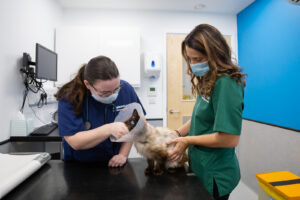
Other commonly asked questions
Does my female cat need to have a litter before she is neutered?
It is a myth that cats need to have a litter of kittens. There are no health or behavioural benefits to your cat having a litter before you get her neutered.
Will neutering my cat make them overweight?
Neutering itself does not make your cat overweight; however, it may mean that they require fewer calories as their metabolism changes.
This means that if they are fed the same amount after neutering as they were before, you may find they start to gain weight.
There are two options to combat this. One is to reduce their daily food intake a little to account for this, the other is to switch to a food formulated for neutered cats which is likely to allow for better calorie control. You can ask your veterinary team for further advice on this.
I heard pregnant cats can still be neutered, is this true?
Cats can be neutered when pregnant, lactating or when they are in season.
It is always advisable to speak to a vet about your cat’s individual health situation so you can discuss what is best for their welfare.
Is it true that your cat’s fur can grow back a different colour where they were clipped to be neutered?
This can be true for some breeds such as Siamese and Ragdoll cats. In these breeds, areas where the skin is cooler tend to grow darker fur.
This is why they have darker coloured extremities such as the ears, nose, paws and tail! If a female cat’s side is clipped for her operation, during her recovery period, this area of skin will be cooler than the surrounding areas and this may encourage the fur to grow back with a darker pigment.
On this basis, some owners may request for their cat to have a midline spay (where the clipped patch is on the underside of the tummy), so it is less noticeable.
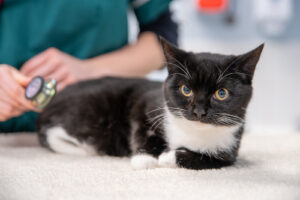
If you have any further questions about neutering your cat or would like to book them in for this procedure, please contact your local vet practice for further support.
Useful resources:
- International Cat Care – Neutering your cat
- Cats Protection – Neutering – Family planning for felines
- The Cat Group – Policy statement 1 – Timing of Neutering
- Blue Cross – Neutering your cat
- RSPCA – Neutering your pet
Found this article helpful? You may also like:
